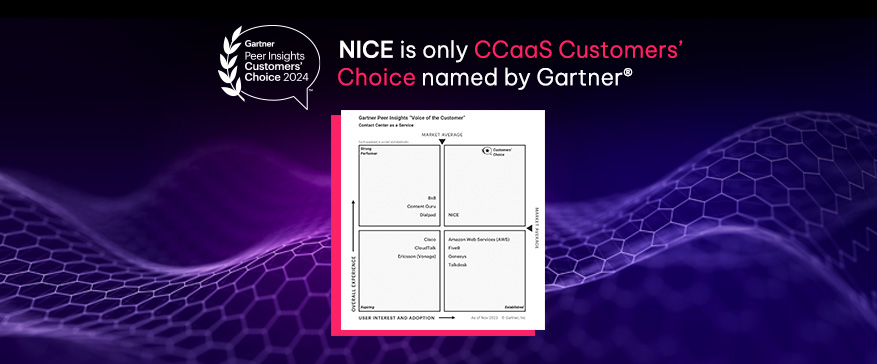Effective Workforce Management when partnering with BPOs
Key Takeaways
- Call models are essential frameworks in contact centers that streamline customer interactions, leading to improved customer satisfaction and operational efficiency.
- There are three primary types of call models—linear, skill-based, and time-based—each tailored to specific business needs and capable of enhancing customer service by optimizing call routing and resource management.
- Advanced call models, such as those offered by NICE, integrate sophisticated technologies like AI and omnichannel platforms to improve customer experience, enhance agent productivity, and reduce operational costs.
Understanding Call Models
Call models are frameworks that define how calls are handled in a contact center. These frameworks provide a structured approach to customer interactions, ensuring that every call is managed efficiently and effectively. Call models play a pivotal role in customer service, as they elucidate employee roles and steer them towards delivering superior service. Unlike call flows, which refer to the conversational flow of an agent’s script or the way a call is routed within the system, call models encompass the different types of approaches used in contact centers to manage these interactions.What is call flow? Call flow highlights the structure of conversation scripts used by agents and the routing processes within call systems. It emphasizes the importance of tailoring conversations based on customer needs and ensuring efficient routing to improve customer experience and brand reputation.A well-structured call model is key to enhancing customer satisfaction. By providing a structured approach, call models help streamline processes, reduce wait times, and ensure that customers reach the right agents quickly. This not only enhances the overall customer experience but also boosts the efficiency of the entire call management system.Types of Call Models
Different types of call models cater to specific business needs and customer requirements. Linear, skill-based, and time-based call models are the three main types. Each model offers unique benefits and can be tailored to fit the specific needs of an organization.Linear Call Model
The linear call model is a straightforward approach where inbound calls are routed directly to available agents or voicemail if no one is available, while outbound calls are initiated by agents as needed. This model is ideal for businesses with simple support needs, as it does not involve complex routing or management, making it an easy-to-implement solution for small enterprises.Despite its simplicity, a linear call flow can be highly effective for managing straightforward customer service call flows, ensuring a smooth conversation flow. By implementing simple strategies for managing a well-designed customer service call flow, businesses can optimize their call handling process, including direct extension call flow, round robin call flow, and flow processes, to improve overall customer satisfaction.Skill-Based Call Model
In a skill-based call model, calls are routed to agents who possess the specific skills required to address the caller’s needs. This model significantly enhances service quality by ensuring that customers are connected with the most qualified agents immediately. By connecting customers with the right agents, skill-based routing improves First Call Resolution (FCR) rates, ensuring that issues are resolved during the initial interaction using a skill based call flow.The benefits of adopting a skill-based call routing system include:- Reducing Average Handle Time (AHT) as agents can address inquiries more efficiently due to their specialized knowledge
- Improving overall customer satisfaction
- Streamlining call handling processes
Time-Based Call Model
Time-based call flow models route calls based on the time of day or week, directing them to different people, departments, or voice messages through a phone system. This approach ensures that calls are managed efficiently during peak and off-peak hours, providing specialized support when needed. For example, calls received after business hours might be directed to a voicemail system or an external support team, ensuring that customers always have a point of contact.Adjusting call routing based on hours business call forwarding can significantly improve the customer experience by ensuring that calls are directed to the appropriate departments or agents. Strategies for managing inbound calls using this model is particularly useful for businesses that experience fluctuating call volumes throughout the day or week, as it helps manage resources more effectively and reduces wait times for customers.Creating an Effective Call Model
Creating an effective call model involves understanding business objectives, customer needs, and integrating these with the right technology. It requires a deep understanding of customer needs and alignment with business goals to ensure consistent and efficient customer interactions.This section will explore the critical steps in designing an effective call model, including mapping the customer journey, leveraging technology, and regular testing and iteration.Mapping the Customer Journey
Mapping the customer journey helps identify all touchpoints where customers interact with the company, ensuring a seamless experience throughout their interaction. Customer touchpoints are the various moments at which a customer directly or indirectly interacts with a brand, and understanding these points is crucial for creating an effective call model. By identifying each touchpoint a customer experiences before, during, and after a purchase, companies can ensure that every interaction is optimized for customer satisfaction. Some examples of customer touchpoints include:- Website visits
- Social media interactions
- Email communications
- Phone calls
- In-store visits
- Product reviews
- Customer support interactions
Leveraging Technology for Call Routing
The effective routing of inbound calls, enhancement of agent performance, and implementation of tools like Intelligent IVR and call management software necessitates the use of technology. Call management systems, such as SignalWire’s Call Flow Builder, provide a user-friendly interface for designing intricate call flows, including auto attendant call flow. IVR systems should implement multi-level auto-attendants to help manage high call volumes with simpler choices and menus. By optimizing call flow processes, businesses can ensure a seamless customer experience.AI tools, including Natural Language Processing (NLP) technology, enable callers to interact with IVR in plain language, creating more intuitive interactions and reducing the need for rigid menu structures. These systems can streamline call flow by pre-screening customers and handling initial steps like identification and the reason for their call, making agents more efficient. Real-time monitoring tools track key performance indicators such as call volume and agent availability, aiding in the swift resolution of issues.Testing and Iteration
Continuous testing and fine-tuning of call models aid in pinpointing areas for enhancement and adjusting to shifts in customer behavior. By ensuring up-to-date information and reducing friction, regular testing ensures a good customer experience. Feedback from test runs should be used to tweak and optimize call flows for better performance.Iterative testing helps businesses adapt to changes in customer behavior and improve service quality. By regularly updating call models to reflect changes in services, promotions, or customer preferences, companies can ensure that their call handling processes remain efficient and effective.Benefits of Implementing Advanced Call Models
Advanced call models offer numerous benefits, including improved customer experience, enhanced agent productivity, and reduced operational costs. These models integrate sophisticated technologies and processes to streamline call handling, reduce the need for call transfers, and provide agents with comprehensive customer information during calls.This section will delve into the specific benefits of implementing advanced call models.Improved Customer Satisfaction and Experience
Investing strategically in advanced call models markedly boosts customer satisfaction, loyalty, and the overall health of the business. Intelligent IVR systems can provide personalized responses based on prior interactions, improving customer satisfaction. Omnichannel integration enables customers to switch between communication channels without repeating their issues, ensuring a seamless customer experience.Balancing customer empathy with technology is crucial to avoid creating ‘engineered insincerity,’ where interactions feel inauthentic or impersonal, leading to frustrated customers. By using automation strategically, businesses can enhance the customer relationship rather than diminish it. Successful call models have significantly improved customer service efficiency and satisfaction across various industries, including retail, financial services, and healthcare.Enhanced Agent Productivity
Advanced call models enhance agent productivity by automating routine tasks and providing agents with detailed customer histories. This allows agents to focus on more complex customer issues, reducing call handling times and improving first-call resolution rates. By reducing the stress associated with high call volumes and repetitive tasks, these models also improve agent morale.Providing agents with comprehensive customer information during calls enables them to resolve issues more quickly and effectively. This not only enhances agent productivity but also boosts overall customer satisfaction, as inquiries are handled more efficiently.Reduced Operational Costs
Reducing operational costs is a significant benefit of implementing advanced call models. Automating call routing and handling can significantly decrease the need for a large workforce. Self-service channels, such as customer portals, enable customers to resolve issues independently, lowering call volume and operational expenses.Optimized call models can reduce the average handling time per call, leading to cost savings. For example, Windstream Holdings used AI-driven platforms to achieve 150% of its subscriber goal and reduce cost per acquisition by 17%.Virtual call centers leverage cloud-based technology to hire center agents from diverse geographic locations, offering flexible services and reducing overhead costs.NICE Call Models
Offering a high degree of customization, NICE call models enable businesses to:- Adjust call flows to meet specific requirements
- Integrate with AI
- Modify call flows without extensive IT involvement
- Scale and grow alongside the organization
Integration with Omnichannel Platforms
By integrating seamlessly with omnichannel platforms, NICE call models ensure a unified customer experience across all touchpoints. By handling customer interactions across various channels, such as phone, email, and social media, NICE CXone enhances customer satisfaction. This unified interaction-centric platform orchestrates customer interactions seamlessly, ensuring a consistent and efficient service experience.NICE CXone combines channels, data, applications, and knowledge to enhance customer experience at scale. With integration across over 30 digital channels, NICE’s omnichannel platform provides visibility into customer interactions and helps improve response quality. This ensures that customers receive consistent and satisfactory service regardless of the channel they use.Advanced Analytical Tools
NICE call models incorporate advanced reporting and analytics features that are vital for monitoring performance and optimizing operations. AI-driven analytics provide valuable insights into customer interactions and agent performance, helping identify trends and areas for improvement. Tools like NICE Enlighten, an AI purpose-built for CX, create exceptional experiences for employees, consumers, and businesses.Advanced call center analytics can provide the following benefits:- Forecast future trends and outcomes using predictive modeling and machine learning
- Determine optimal agent staffing levels during peak periods, reducing unnecessary labor costs
- Extract insights from customer interactions to identify sentiments and common issues, optimizing processes and improving customer satisfaction
Scalability and Adaptability
Designed with scalability in mind, NICE call models accommodate business growth, managing increasing call volumes and complexity. The cloud-native nature of NICE CXone allows it to scale securely, deploy quickly, and satisfy customers globally. This adaptability ensures that call models can be quickly modified in response to changing customer needs.NICE solutions offer:- Scalability and adaptability to evolve with technological advancements
- Long-term viability for businesses
- Enhanced call handling processes
- Improved overall customer satisfaction
Real-World Examples of Successful Call Models
Real-world examples of successful call models demonstrate their effectiveness in various industries. Here are some examples:A retail company improved customer satisfaction with a skill-based call model.
A financial services firm reduced operational costs with a time-based call model.
A healthcare provider streamlined patient support with a linear call model.
Case Study 1: Retail Industry
A fast-growing online retailer improved customer service and reduced waiting times by implementing a skill-based call routing system. This approach resulted in a marked increase in first-call resolution rates and customer satisfaction. By routing calls to the most qualified agents, the retailer achieved a 15% improvement in first-call resolution rates and a 20% reduction in average call handling time.The improved efficiency allowed the retailer’s marketing and advertising teams to focus on core tasks, resulting in more successful campaigns and higher sales.Case Study 2: Financial Services
A financial services firm adopted a time-based call model, which resulted in the following benefits:- Optimized call schedules
- Reduced wait times
- Reduced operational costs by 25%
- Increased efficiency of handling customer queries by 30%









